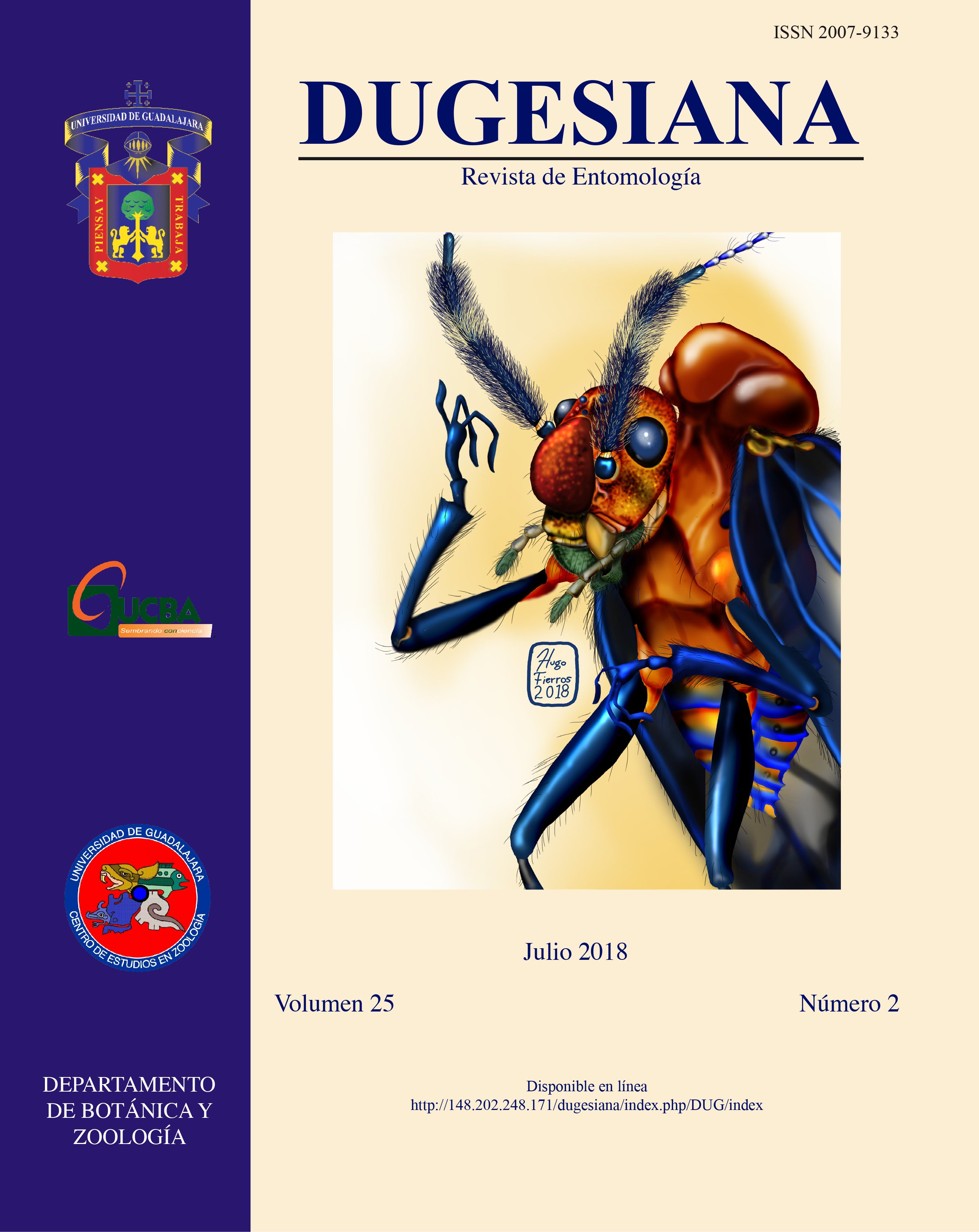Primer registro de Laetilia coccidivora (Lepidoptera: Pyralidae) como depredador de Diaspis echinocacti (Hemiptera: Diaspididae) en Tlalnepantla, Morelos
DOI:
https://doi.org/10.32870/dugesiana.v25i2.6738Keywords:
nopal, plagas, insectos escama, enemigos naturalesAbstract
Se registra por primera vez la escama armada Diaspis echinocacti como una presa del pirálido Laetilia coccidivora en cultivos de nopal verdura de Tlalnepantla, Morelos. Se discute sobre poblaciones de insectos escama asociados al cultivo de nopal de esta región.References
Aldama-Aguilera, C., C. Llanderal-Cázares, M. Soto-Hernández and L. E. Castillo Márquez. 2005. Cochineal (Dactylopius coccus Costa) production in prickly pear plants in the open and in microtunnel greenhouses. Agrociencia 39(2): 161-171.
Chávez-Moreno, C. K., A. Tecante, and A. Casas. 2009. The Opuntia (Cactaceae) and Dactylopius (Hemiptera: Dactylopiidae) in Mexico: a historical perspective of use, interaction and distribution. Biodiversity and Conservation, 18(13): 3337-3355.
Cruz-Rodríguez J. A., E. González-Machorro, A. A. Villegas ,González, M. L. Rodríguez Ramírez, and F. Mejía Lara. 2016. Autonomous biological control of Dactylopius opuntiae (Hemiptera: Dactylopiidae) in a prickly pear plantation with ecological management. Environmental Entomology, 45 (3):642-648.
De Lotto, G. 1974. On the status of the cochineal insects (Homoptera: Coccoidea: Dactylopiidae). Journal of Entomological Society of South Africa, 37: 167-193.
De Souza, F., M. J. Cerqueira, H. Monaísy, V. de Melo, M. Forti, and D. M. Passos. 2009. Control of Diaspis echinocacti (Bouché, 1833) (Hemiptera: Diaspididae). In: Prickly-Pear. In: Proceedings of the VI International Congress on cactus and Cochineal. Acta Horticulturae, (811): 223-226.
García, M, B. D. Denno, D. R. Miller, G. L. Miller, Y. Ben-Dov, and N.B. Hardy. 2016. ScaleNet: A literature-based model of scale insect biology and systematics. Database. http://scalenet.info. Consultado el 25 de enero de 2017.
Gill, R. J. 1997 The Scale Insects of California: Part 3. The Armored Scales (Homoptera:Diaspididae).California Department of Food & Agriculture Sacramento,CA 307p.
Hamon, A. B. and M. L. Kosztarab. 1979. Morphology and systematic of the first instar of the genus Cerococcus (Homoptera: Coccoidea: Cerococcidae). Virginia Polytechnic Institute and State University. Research Division, (146): 1-122.
Lima, I. M. M. and N. S. Gama. 2001. Registro de plantas hospedeiras (Cactaceae) e de nova forma de disseminação de Diaspis echinocacti (Bouché) (Hemiptera: Diaspididae), Cochonilha-da-Palma-Forrageira, nos Estados de Pernambuco e Alagoas. Neotropical Entomology, 30(3): 479-481.
Miller, D. R. and J. A. Davidson. 2005. Armored Scale Insect Pests of Trees and Shrubs. Cornell Univ. Press Ithaca, NY 442 p.
Powell, J. A. 1980. Five insects believed to be newly established or recorded on Santa Cruz Island, California (Dermaptera, Lepidoptera). Bulletin of Southern California Academic of Science, 79(3):97−108.
Portillo, L. and A. L. Vigueras. 2006. A review on the cochineal species in México, host and natural enemies. Acta Horticulturae, 728: 249−255.
Russo, A. and Siscaro, G. 1994 Diaspis echinocacti fitomizo del fico d’India in Sicilia. Informatore Agrario, 50(37): 73-76.
SIAP. Servicio de Información Agroalimentaria y Pesquera Cierre de producción anual 2015. http://infosiap. siap.gob.mx/aagricola_siap_gb/ientidad/index. jsp. Consultado el 05 de abril de 2017.
Solis, M. A. 2008. Pyraloidea and Their Known Hosts (Insecta: Lepidoptera) of Plummers Island, Maryland. Bulletin of the Biological Society of Washington, 15(1): 88-106.
Vanegas-Rico J. M., J. R. Lomeli-Flores, E. Rodríguez-Leyva, G. Mora-Aguilera y J. Valdez. 2010. Enemigos naturales de Dactylopius opuntiae (Cockerell) en Opuntia ficus-indica (L.) Miller en el centro de México. Acta Zoológica Mexicana (n.s.), 26(2): 415-433.
Vanegas-Rico, J. M., A. Pérez-Panduro, J. R. Lomeli-Flores, E. Rodríguez-Leyva, J. M. Valdez, G. Mora-Aguilera. 2017 - Dactylopius opuntiae (Hemiptera:Dactylopiidae) population fluctuations and predators in Tlalnepantla, Morelos. Folia Entomológica Mexicana 3(2):23-31.
Williams M. L. 1993. Toumeyella lignumvitae, a new species of scale insect from the Florida keys (Homoptera:Coccidae). Florida Entomologist, 76(4): 566-572.
Additional Files
Published
Issue
Section
License
1. Proposed policy for open access journals
Those authors who have publications with this journal, accept the following terms:
- The authors will retain their copyright and will guarantee to the journal the right of first publication of their work, which will be simultaneously subject to the Creative Commons Recognition License, which allows third parties to share the work whenever their author is indicated and His first publication is this journal.
- Authors may adopt other non-exclusive license agreements to distribute the version of the published work (eg to be deposited in an institutional telematic file or published in a monographic volume) provided the initial publication is indicated in this journal .
Authors are encouraged and encouraged to disseminate their work through the Internet (eg in institutional telematic files or on their web page) before and during the sending process, which can produce interesting exchanges and increase appointments Of the published work. (See The effect of open access).
2. Proposed policy for journals that offer open deferred access
Those authors who have publications with this journal, accept the following terms:
- The authors will retain their copyrights and will guarantee to the journal the right of first publication of their work [SPECIFY PERIOD OF TIME], which will be simultaneously subject to the Creative Commons Recognition License that allows third parties to share the work always That its author and his first publication be indicated this journal.
- Authors may adopt other non-exclusive license agreements to distribute the version of the published work (eg to be deposited in an institutional telematic file or published in a monographic volume) provided the initial publication is indicated in this journal .
- Authors are encouraged and encouraged to disseminate their work through the Internet (eg in institutional telematic files or on their web page) before and during the sending process, which can produce interesting exchanges and increase appointments Of the published work. (See The effect of open access).




